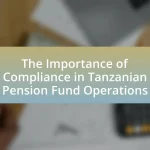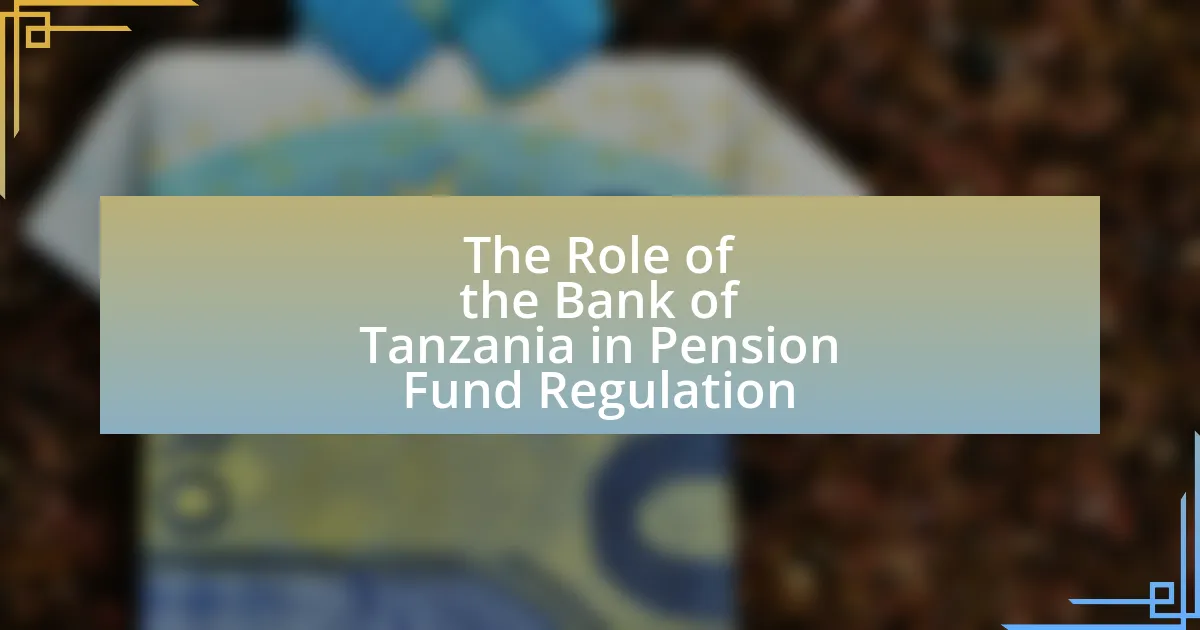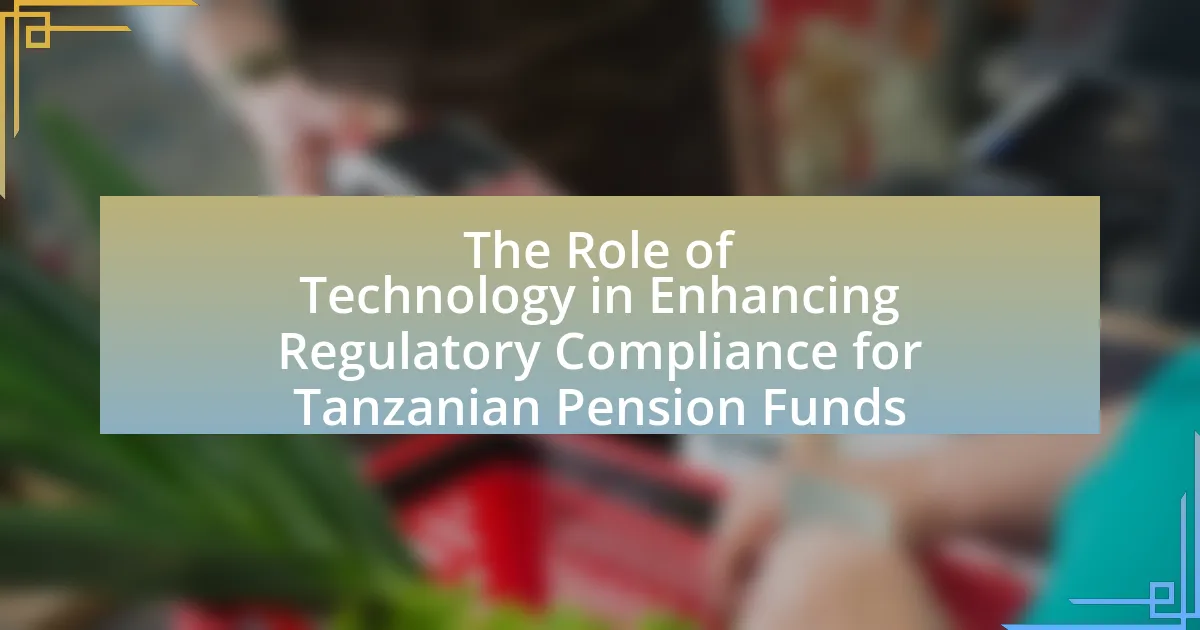The article focuses on the evolving landscape of pension fund regulation in Tanzania, highlighting current trends such as increased transparency, improved governance frameworks, and the integration of technology in fund management. It examines the impact of recent economic changes, including market volatility and demographic shifts, on regulatory requirements and pension fund sustainability. Additionally, the article discusses the role of technology in enhancing compliance and operational efficiency, while addressing potential risks associated with these advancements. Key strategies for stakeholders and policymakers are outlined to adapt to regulatory changes and ensure the long-term viability of pension systems in Tanzania.
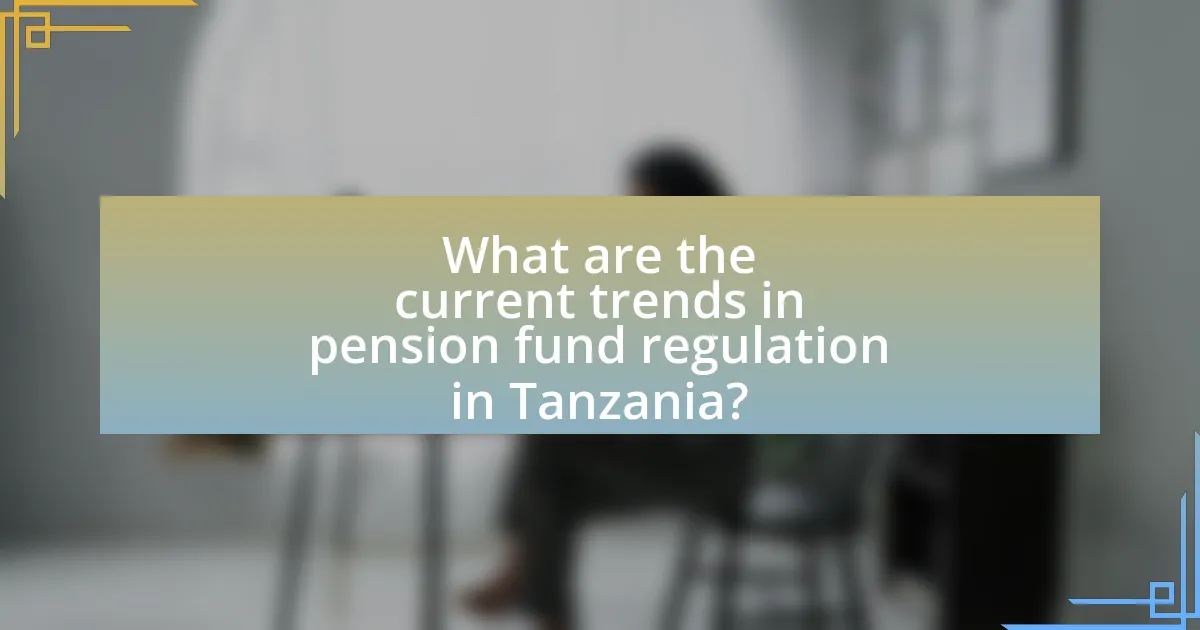
What are the current trends in pension fund regulation in Tanzania?
Current trends in pension fund regulation in Tanzania include increased emphasis on transparency, improved governance frameworks, and the adoption of technology for better fund management. The Tanzanian government has been implementing reforms aimed at enhancing the regulatory environment, which includes the introduction of stricter reporting requirements and the promotion of risk-based supervision. Additionally, the National Social Security Fund (NSSF) has been actively working to modernize its operations through digital platforms, facilitating easier access for contributors and beneficiaries. These trends are supported by the need to ensure the sustainability and efficiency of pension funds in light of demographic changes and economic challenges.
How have recent economic changes influenced pension fund regulations?
Recent economic changes have led to stricter pension fund regulations in Tanzania, primarily due to increased market volatility and the need for greater financial stability. The Tanzanian government has responded to economic fluctuations by implementing regulations that require pension funds to maintain higher capital reserves and diversify their investment portfolios. For instance, the introduction of the new Capital Markets and Securities Authority guidelines mandates that pension funds allocate a minimum percentage of their assets to government bonds, ensuring a more stable investment environment. This regulatory shift aims to protect retirees’ savings and enhance the overall resilience of the pension system in the face of economic uncertainties.
What specific economic factors are driving regulatory changes?
Economic factors driving regulatory changes in Tanzania’s pension fund sector include demographic shifts, economic growth, and financial market development. The aging population increases the demand for sustainable pension systems, necessitating regulatory adaptations to ensure long-term viability. Additionally, Tanzania’s GDP growth, projected at 5.5% in 2023, creates a need for regulations that support investment opportunities and protect beneficiaries. Furthermore, the evolution of financial markets, including the rise of digital finance, requires updated regulations to address new risks and enhance transparency. These factors collectively influence the regulatory landscape to promote stability and protect stakeholders in the pension fund system.
How do these economic changes impact pension fund sustainability?
Economic changes significantly impact pension fund sustainability by altering investment returns, funding levels, and demographic trends. For instance, low interest rates can reduce the yield on fixed-income investments, which are a major component of pension portfolios, leading to lower overall returns. Additionally, economic downturns can increase unemployment rates, resulting in reduced contributions to pension funds and potential liquidity issues. Furthermore, demographic shifts, such as an aging population, increase the number of beneficiaries relative to active contributors, straining the fund’s resources. According to the World Bank, pension funds in developing countries like Tanzania face challenges due to these economic factors, necessitating reforms to ensure long-term viability and sustainability.
What role does technology play in the future of pension fund regulation?
Technology will play a crucial role in the future of pension fund regulation by enhancing transparency, efficiency, and compliance. Advanced data analytics and artificial intelligence will enable regulators to monitor pension funds in real-time, identifying risks and ensuring adherence to regulations more effectively. For instance, blockchain technology can provide immutable records of transactions, which increases trust and reduces fraud. Additionally, digital platforms can streamline reporting processes, making it easier for pension funds to comply with regulatory requirements. These technological advancements are essential for adapting to the evolving financial landscape and ensuring the sustainability of pension systems in Tanzania.
How is technology transforming pension fund management practices?
Technology is transforming pension fund management practices by enhancing data analytics, improving operational efficiency, and enabling better risk management. Advanced data analytics tools allow pension funds to analyze vast amounts of data quickly, leading to more informed investment decisions and personalized member services. Automation technologies streamline administrative processes, reducing costs and minimizing human error. Additionally, technology facilitates real-time monitoring of investment performance and risk exposure, which is crucial for adapting to market changes. For instance, the use of artificial intelligence in predictive analytics has been shown to improve investment outcomes by up to 20%, demonstrating the significant impact of technology on pension fund management.
What are the potential risks associated with technological advancements?
Technological advancements pose several potential risks, including cybersecurity threats, job displacement, and ethical concerns. Cybersecurity threats arise as increased connectivity and reliance on digital systems make sensitive data more vulnerable to breaches; for instance, the 2020 SolarWinds cyberattack compromised numerous organizations, highlighting the risks associated with advanced technology. Job displacement occurs as automation and artificial intelligence replace traditional roles, with a World Economic Forum report predicting that 85 million jobs may be displaced by 2025 due to automation. Ethical concerns also emerge, particularly regarding data privacy and algorithmic bias, as seen in controversies surrounding facial recognition technology, which can perpetuate discrimination. These risks necessitate careful consideration and regulation to mitigate their impact on society.
What are the implications of demographic shifts on pension fund regulation?
Demographic shifts significantly impact pension fund regulation by altering the balance between active workers and retirees. As populations age, the ratio of contributors to beneficiaries declines, leading to increased pressure on pension systems to ensure sustainability. For instance, in Tanzania, the proportion of the population aged 65 and older is projected to rise from 3.2% in 2020 to 5.5% by 2050, which necessitates regulatory adjustments to accommodate longer life expectancies and increased payouts. Consequently, regulators may need to implement stricter funding requirements, adjust retirement ages, or enhance investment strategies to maintain solvency and protect beneficiaries’ interests.
How do aging populations affect pension fund liabilities?
Aging populations increase pension fund liabilities due to a higher number of retirees drawing benefits for longer periods. As life expectancy rises, pension funds face greater financial strain because they must provide payouts for extended durations, leading to a growing gap between contributions and disbursements. For instance, in many developed countries, the ratio of workers to retirees has decreased significantly, which exacerbates the funding challenges for pension systems. According to the World Bank, by 2050, the global population aged 65 and older is projected to reach 1.5 billion, further intensifying the pressure on pension funds to meet their obligations.
What strategies can be implemented to address demographic challenges?
To address demographic challenges, strategies such as enhancing pension fund regulations, promoting workforce participation, and implementing family-friendly policies can be implemented. Enhancing pension fund regulations ensures that funds are managed sustainably, adapting to changing demographics, such as an aging population. Promoting workforce participation, especially among women and older individuals, can mitigate the economic impact of demographic shifts. Family-friendly policies, including parental leave and childcare support, can encourage higher birth rates and support working families. These strategies are supported by evidence showing that countries with robust pension systems and inclusive labor markets experience better economic stability in the face of demographic changes.

What predictions can be made about the future of pension fund regulation in Tanzania?
Predictions about the future of pension fund regulation in Tanzania indicate a trend towards increased transparency and stricter compliance measures. The Tanzanian government is likely to enhance regulatory frameworks to protect beneficiaries and ensure the sustainability of pension funds, driven by the need for improved financial security for retirees. Recent initiatives, such as the establishment of the Social Security Regulatory Authority, demonstrate a commitment to strengthening oversight and governance in the sector. Additionally, the integration of technology in pension management is expected to facilitate better monitoring and reporting, aligning with global best practices. These developments suggest a proactive approach to addressing challenges within the pension system, ultimately aiming to foster public confidence and financial stability.
How might regulatory frameworks evolve in the next decade?
Regulatory frameworks in Tanzania are likely to evolve towards increased transparency and accountability in pension fund management over the next decade. This evolution will be driven by the need to protect beneficiaries’ interests and ensure sustainable fund performance. For instance, the Tanzanian government has already initiated reforms aimed at enhancing regulatory oversight, as seen in the establishment of the Social Security Regulatory Authority, which aims to improve governance and compliance among pension funds. Additionally, global trends towards digitalization and data-driven decision-making will influence local regulations, promoting the adoption of technology in monitoring and reporting practices. These changes are expected to align with international best practices, ensuring that pension funds operate efficiently and securely, ultimately benefiting the pensioners in Tanzania.
What are the anticipated changes in compliance requirements?
Anticipated changes in compliance requirements for pension fund regulation in Tanzania include the implementation of stricter governance standards and enhanced reporting obligations. These changes are driven by the need for increased transparency and accountability in the management of pension funds, as highlighted by the Tanzanian government’s commitment to align with international best practices. For instance, the Financial Sector Development Plan emphasizes the importance of robust regulatory frameworks to protect beneficiaries’ interests and ensure the sustainability of pension schemes.
How will international standards influence local regulations?
International standards will significantly influence local regulations by providing a framework that enhances compliance, transparency, and governance in pension fund management. These standards, such as those set by the International Organization for Standardization (ISO) or the International Financial Reporting Standards (IFRS), serve as benchmarks that local regulators can adopt to align with global best practices. For instance, the adoption of IFRS in many countries has led to improved financial reporting and accountability in pension funds, thereby fostering investor confidence and protecting beneficiaries’ interests. This alignment not only facilitates international investment but also encourages local pension funds to adopt more rigorous risk management and operational practices, ultimately leading to a more robust regulatory environment in Tanzania.
What potential challenges could arise in future pension fund regulation?
Potential challenges in future pension fund regulation in Tanzania include inadequate regulatory frameworks, which may fail to address emerging financial risks, and the lack of transparency in fund management, leading to potential misallocation of resources. Additionally, demographic shifts, such as an aging population, could strain pension systems, while economic volatility may impact fund performance. Historical data indicates that countries with similar regulatory environments have faced these issues, underscoring the need for robust governance and adaptive regulatory measures to ensure sustainability and protect beneficiaries.
What are the risks of regulatory non-compliance for pension funds?
The risks of regulatory non-compliance for pension funds include financial penalties, legal repercussions, and reputational damage. Financial penalties can arise from regulatory bodies imposing fines for failing to adhere to established guidelines, which can significantly impact the fund’s financial health. Legal repercussions may involve lawsuits from beneficiaries or stakeholders, leading to costly litigation and potential settlements. Reputational damage can result in a loss of trust among members and the public, which may deter future investments and affect the fund’s ability to attract new participants. According to the International Labour Organization, non-compliance can also lead to increased scrutiny from regulators, further complicating operational processes and increasing costs.
How can pension funds prepare for potential regulatory changes?
Pension funds can prepare for potential regulatory changes by conducting regular assessments of their compliance frameworks and staying informed about emerging regulations. This proactive approach allows pension funds to identify gaps in their current practices and adapt to new legal requirements effectively. For instance, the Tanzanian pension sector has seen shifts in regulatory frameworks, necessitating funds to engage in continuous dialogue with regulatory bodies and industry stakeholders to anticipate changes. By participating in industry forums and subscribing to regulatory updates, pension funds can ensure they remain compliant and mitigate risks associated with non-compliance.
What opportunities might emerge from evolving pension fund regulations?
Evolving pension fund regulations in Tanzania may create opportunities for increased investment diversification and enhanced financial inclusion. As regulations adapt to global standards, pension funds can explore new asset classes, such as infrastructure and green investments, which can yield higher returns and support sustainable development. Additionally, improved regulatory frameworks can facilitate access to pension services for underserved populations, thereby expanding the customer base and promoting economic growth. For instance, the introduction of digital platforms for pension management can streamline operations and reduce costs, making it easier for individuals to participate in pension schemes.
How can pension funds leverage regulatory changes for growth?
Pension funds can leverage regulatory changes for growth by adapting their investment strategies to align with new regulations that promote sustainable and responsible investing. For instance, recent regulatory shifts in Tanzania encourage pension funds to invest in green projects and infrastructure, which can yield higher returns while fulfilling compliance requirements. By reallocating assets towards sectors favored by these regulations, such as renewable energy, pension funds can enhance their portfolios and contribute to national development goals. This approach is supported by the fact that investments in sustainable sectors have shown resilience and growth potential, as evidenced by global trends where sustainable investments have outperformed traditional ones in various markets.
What innovative practices can be adopted in response to new regulations?
Innovative practices that can be adopted in response to new regulations include the implementation of advanced technology solutions such as blockchain for transparency and efficiency in transactions. Blockchain technology can enhance the security and traceability of pension fund transactions, ensuring compliance with regulatory requirements. Additionally, adopting data analytics tools can help pension funds better assess risk and optimize investment strategies in line with new regulations. For instance, using predictive analytics can enable funds to anticipate market changes and adjust their portfolios accordingly, thereby adhering to regulatory standards while maximizing returns. These practices not only ensure compliance but also improve operational efficiency and stakeholder trust in the pension fund system.
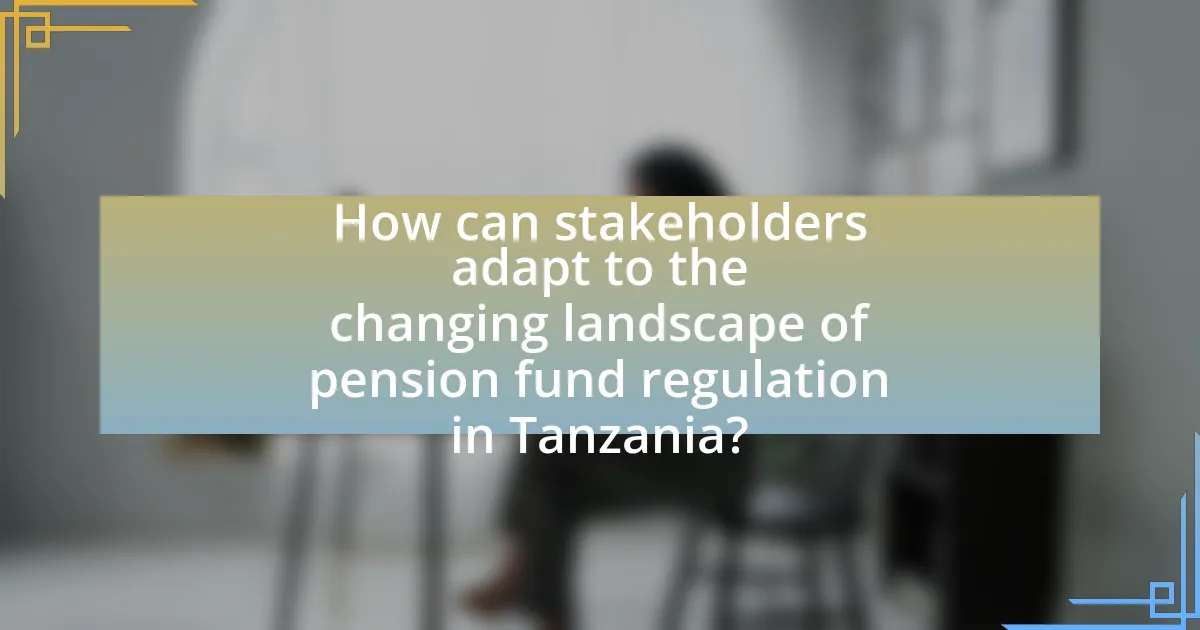
How can stakeholders adapt to the changing landscape of pension fund regulation in Tanzania?
Stakeholders can adapt to the changing landscape of pension fund regulation in Tanzania by actively engaging in continuous education and training on regulatory updates. This proactive approach enables stakeholders, including fund managers and trustees, to stay informed about new laws and compliance requirements, which have evolved significantly in recent years due to government reforms aimed at enhancing transparency and accountability in the pension sector. For instance, the introduction of the Social Security Regulatory Authority (SSRA) in 2008 has led to stricter oversight and guidelines that stakeholders must follow. By participating in workshops and seminars organized by the SSRA and other industry bodies, stakeholders can better understand the implications of these regulations and adjust their strategies accordingly.
What best practices should pension fund managers adopt?
Pension fund managers should adopt a diversified investment strategy to mitigate risks and enhance returns. Diversification allows managers to spread investments across various asset classes, reducing the impact of poor performance in any single investment. According to a study by the CFA Institute, diversified portfolios can achieve better risk-adjusted returns over time, which is crucial for meeting long-term obligations to beneficiaries. Additionally, pension fund managers should implement robust governance frameworks that include regular performance evaluations and compliance checks to ensure adherence to regulatory standards. This practice is supported by the International Organization of Pension Supervisors, which emphasizes the importance of governance in maintaining the integrity and sustainability of pension funds.
How can transparency and accountability be enhanced in pension fund operations?
Transparency and accountability in pension fund operations can be enhanced through the implementation of robust reporting standards and independent audits. Establishing clear guidelines for financial disclosures ensures that stakeholders receive accurate and timely information regarding fund performance and management practices. For instance, the International Financial Reporting Standards (IFRS) provide a framework that can be adopted to improve financial transparency. Additionally, regular independent audits conducted by certified external auditors can verify the integrity of financial statements, thereby fostering trust among beneficiaries. Research indicates that pension funds with higher transparency levels tend to have better investment performance and lower operational risks, as evidenced by a study published in the Journal of Pension Economics and Finance, which highlights the correlation between transparency and fund efficiency.
What role does stakeholder engagement play in regulatory adaptation?
Stakeholder engagement is crucial in regulatory adaptation as it ensures that diverse perspectives are considered, leading to more effective and inclusive regulations. Engaging stakeholders, such as pension fund managers, beneficiaries, and policymakers, allows for the identification of practical challenges and opportunities within the regulatory framework. This collaborative approach fosters trust and transparency, which are essential for the successful implementation of regulatory changes. Evidence from various regulatory environments shows that jurisdictions with active stakeholder participation tend to have more resilient and adaptive regulations, as they are better aligned with the needs and realities of those affected.
What strategies can policymakers implement to support effective regulation?
Policymakers can implement strategies such as enhancing stakeholder engagement, utilizing data-driven decision-making, and establishing clear regulatory frameworks to support effective regulation. Enhancing stakeholder engagement involves actively involving pension fund participants, employers, and industry experts in the regulatory process, which can lead to more informed and accepted regulations. Utilizing data-driven decision-making allows policymakers to analyze trends and outcomes, ensuring regulations are based on empirical evidence rather than assumptions. Establishing clear regulatory frameworks provides a structured approach that delineates roles, responsibilities, and compliance requirements, which can reduce ambiguity and foster adherence among pension funds. These strategies are supported by evidence from successful regulatory practices in various countries, demonstrating that inclusive and informed policymaking leads to more effective regulatory outcomes.
How can collaboration between stakeholders improve regulatory outcomes?
Collaboration between stakeholders can significantly improve regulatory outcomes by fostering a comprehensive understanding of diverse perspectives and needs. When various stakeholders, including government agencies, pension fund managers, and beneficiaries, engage in dialogue, they can identify potential regulatory gaps and develop more effective policies. For instance, the International Monetary Fund (IMF) emphasizes that stakeholder collaboration leads to better-informed decisions, which can enhance compliance and reduce risks associated with pension fund management. This collaborative approach not only promotes transparency but also builds trust among stakeholders, ultimately resulting in more robust regulatory frameworks that are responsive to the evolving landscape of pension fund regulation in Tanzania.
What frameworks can be established to ensure ongoing regulatory effectiveness?
To ensure ongoing regulatory effectiveness in pension fund regulation in Tanzania, a comprehensive framework that includes continuous stakeholder engagement, adaptive regulatory mechanisms, and robust compliance monitoring should be established. Continuous stakeholder engagement involves regular consultations with pension fund managers, beneficiaries, and government entities to align regulatory practices with evolving market conditions and stakeholder needs. Adaptive regulatory mechanisms allow for timely updates to regulations based on emerging trends, such as technological advancements and demographic shifts, ensuring that the regulatory framework remains relevant. Robust compliance monitoring, supported by data analytics and reporting systems, enables regulators to track adherence to regulations and identify areas for improvement, thereby enhancing accountability and transparency in the pension fund sector.
What practical steps can pension fund participants take to navigate future regulations?
Pension fund participants can navigate future regulations by actively engaging in continuous education about regulatory changes and participating in industry forums. Staying informed allows participants to understand emerging trends and compliance requirements, which are crucial for adapting to new regulations. For instance, the Tanzanian pension sector has seen significant reforms aimed at enhancing transparency and governance, making it essential for participants to familiarize themselves with these changes. Additionally, collaborating with financial advisors and legal experts can provide tailored guidance, ensuring that participants make informed decisions that align with regulatory expectations.
How can individuals stay informed about regulatory changes affecting their pensions?
Individuals can stay informed about regulatory changes affecting their pensions by regularly consulting official government websites and subscribing to updates from relevant regulatory bodies. For instance, in Tanzania, the National Social Security Fund (NSSF) and the Pension Fund Regulatory Authority (PFRA) provide updates on policy changes and regulatory developments. Additionally, individuals can follow financial news outlets and industry publications that cover pension regulations, ensuring they receive timely information. Engaging with financial advisors who specialize in pensions can also provide personalized insights into regulatory changes that may impact individual pension plans.
What resources are available for pension fund participants to understand their rights and obligations?
Pension fund participants in Tanzania can access several resources to understand their rights and obligations. These resources include the Pension Act, which outlines the legal framework governing pension funds, and guidelines issued by the National Social Security Fund (NSSF) that provide detailed information on benefits and entitlements. Additionally, participants can utilize educational materials and workshops organized by pension fund administrators, which aim to enhance awareness of pension rights. The Tanzania Pension Regulatory Authority (TPRA) also offers online resources and publications that clarify participants’ rights and obligations, ensuring compliance with regulations.


